If the Label Is Skinny Enough – No Inducement Under Hatch-Waxman | McDermott Will & Emery
[author: Ian Howard*]
The US Court of Appeals for the Federal Circuit made explicit what has long been considered implicit based on Warner-Lambert and its progeny, namely, that plaintiffs asserting an induced infringement theory to bar the entry of generic drugs in a Hatch-Waxman suit are subject to higher scrutiny than plaintiffs asserting the same theories outside of the Hatch-Waxman context. H. Lundbeck A/S v. Lupin Ltd., Case No. 22-1194 (Fed. Cir. Dec. 7, 2023) (Dyk, Prost, Hughes, JJ.)
Lundbeck owns the approved new drug application (NDA) for Trintellix®, a drug indicated for the treatment of major depressive disorder (MDD), as well as an expired compound patent for the associated active ingredient vortioxetine. Lundbeck also owns a patent that claims the use of vortioxetine as an antidepressant that can be prescribed in place of a traditional antidepressant to alleviate a patient’s negative sexual side effects, and another patent that claims the use of vortioxetine to treat cognitive impairment symptoms in patients with MDD.
Generic pharmaceutical companies filed abbreviated new drug applications (ANDAs) seeking approval to market generic versions of Trintellix® and asserting that Lundbeck’s unexpired patents listed in its NDA were invalid and would not be infringed by the generic companies. As required by the Hatch-Waxman Act (to prevent the entry of a generic on the market), Lundbeck sued the generic companies. At the district court, the defendants prevailed on the finding of noninfringement but lost on invalidity. Lundbeck appealed.
Lundbeck pressed its induced infringement and contributory infringement theories on appeal. Lundbeck argued that the generics infringed under the plain text of Hatch-Waxman (35 USC 271(e)(2)(A)) because they filed ANDAs seeking approval to market vortioxetine, and that “some uses of vortioxetine—for the treatment of patients that have previously taken other drugs but had to cease or reduce use due to sexually related adverse events and for the treatment of cognitive impairment—are covered by [Lundbeck’s listed] patents; and the labels do not prohibit prescribing vortioxetine for those uses, even though the defendants do not propose to market the drug for those patented uses.” In other words, Lundbeck argued that in terms of its inducement allegation, it made no difference whether a drug would be sold for a use not covered by Lundberg’s NDA-listed patents because the drug could be prescribed for those patented uses.
The Federal Circuit disagreed, explaining that “‘the use’ in § 271(e)(2)(A) refers to the use for which the FDA has granted an NDA” and for which the ANDA was submitted.” The Court emphasized that it is not “an act of infringement under . . . § 271(e)(2)(A) to submit an ANDA for a drug if just any use of that drug were claimed in a patent.” If it were, a brand could “maintain its exclusivity merely by regularly filing a new patent application claiming a narrow method of use not covered by its NDA,” which “would confer substantial additional rights on pioneer drug patent owners that Congress quite clearly did not intend to confer.” As the Court then held, “actions for infringement of method of use patents under section 271(e)(2)(A) are limited to patents that claim an indication of the drug for which indication the applicant is seeking approval.”
Where a proposed ANDA label does not on its face encourage infringing uses of a drug, the Federal Circuit agreed that courts may scrutinize outside communications that propose to market the drug. But here, the defendants did not propose to market the drug for a use covered by the NDA-listed patents. Because the defendants’ ANDA labels, consistent with Hatch-Waxman statutory directives, excluded data included in the NDA label that related to the asserted patents, the Federal Circuit concluded that the defendants had not induced infringement, notwithstanding possible off-label use by prescribing physicians.
The Federal Circuit also noted that, even considering that defendants filed their ANDA label knowing that some physicians might prescribe the medication for infringing uses, the defendants had not induced infringement because a finding of induced infringement in these circumstances would be inconsistent with the Hatch-Waxman Act’s purpose. As the Court explained, patentees should not be able to extend their exclusivity merely by filing new patent applications covering different uses of the same drug. However, the Federal Circuit noted that in an appropriate case where a patent is an essential improvement on the safety of a drug, a new patent could have the effect of extending exclusivity.
Regarding Lundbeck’s contributory infringement appeal, the Federal Circuit concluded that the defendants did not contributorily infringe the asserted patents because there were substantial non-infringing uses of vortioxetine.
Practice Notes: Lundbeck requires that in a Hatch-Waxman suit, a court must scrutinize not only the patents-in-suit but also predecessor patents listed in the NDA to evaluate whether the plaintiff is engaging in gamesmanship to unjustly extend exclusivity.
To forestall the entry of generics on an induced infringement theory, brand pharmaceutical companies should ensure that any follow-on patents asserted after the primary NDA patents have expired are essential improvements on a drug’s safety.
From its holding here, it seems clear that the Federal Circuit views the purpose of the Hatch-Waxman Act, as it relates to induced infringement, to limit allegations of inducement to the uses presented in the NDA. Thus, while skinny label conduct may not constitute induced infringement in a Hatch-Waxman context, that same conduct may invoke induced infringement outside of that context.
*Ian Howard is a law clerk in the Washington, DC, office with a focus on intellectual property litigation matters.
[View source.]





